Each week, an additional insect (or spider) from my garden will be added. Whilst this is not food-related, it is garden-related and therefore of potential interest to the many of you who are gardeners. If you want to identify an insect that you have photographed, Museums Victoria’s Ask a Question is a great resource.
Ants, bees, wasps and sawflies (Hymenoptera)
|
Banded sugar ant (Camponotus consobrinus)
The top photo is of a colony of banded sugar ants (Camponotus consobrinus). As you can see, they don’t have wings.
The bottom photo is of a group of winged banded sugar ants getting ready to swarm. These are a mix of virgin queens and male drones. They are about to fly off to establish other colonies. Once they mate, the males will die and the females will shed their wings.
Banded sugar ants are a bit larger than your average ant (around 1cm long) but don’t often bite. They are mostly nocturnal and usually farm aphids (for their honeydew), taking the aphids out at night to feed.
My banded sugar ants have multiple nests which they often move between around both dawn and dusk.
|
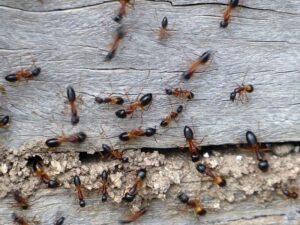
 |
Spitfire sawfly (Perga affinis)
The left hand photo (from my garden) is of a group of spitfire sawfly larvae (Perga affinis) and the right hand one (from the Internet) is of an adult.
Whilst the adults of this species are not often seen, the larvae are quite conspicuous, resembling large (up to 8cm long) hairy caterpillars.
The larvae rest in groups during the day (as in the photo) and then disperse at night to feed.
When they feel threatened, the larvae raise their heads, collectively resembling a much bigger creature, and can eject a strong-smelling, yellow-green liquid consisting predominantly of eucalyptus oil (hence the common name of spitfires).
Despite being called flies, sawflies are actually more closely related to ants and bees than to flies.
|
 |
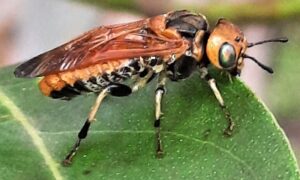 |
Beetles (Coleoptera)
|
Common spotted ladybird (Harmonia conformis)
The left hand photo is of a juvenile/larva whilst the right hand one is of an adult.
Both adults and larvae are predators, feeding on aphids and the like. The adults always have the same number of spots (20). The larvae have different numbers of orange stripes, depending on their age.
The common spotted ladybird is indigenous to Australia.
Ladybirds are a type of beetle. Beetles, like butterflies but unlike true bugs, undergo complete metamorphosis via pupation from non-flying, non-mating larva to flying, mating adult. Most beetle larvae are much more grub-like than those of the ladybird.
|
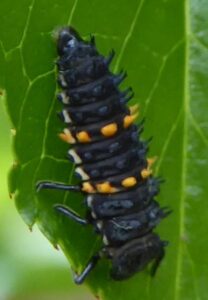 |
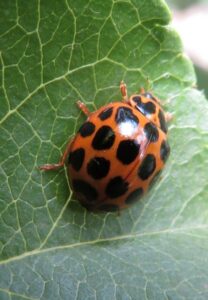 |
Fungus-eating ladybird (Illeis galbula)
The left hand photo (from the Internet) is of a juvenile/larva whilst the right hand one (from Pam Jenkins’ garden) is of an adult.
Both the juveniles and the adults eat fungus, particularly the powdery mildew on cucurbit crops like pumpkin and zucchini. The overwintering adults apparently feed on the pollen of wattles and privets during spring.
Pam says: “In spite of living on a windy hill, I have a lot of fungus amongst my leafy greens, mainly powdery mildew. Nature has provided a specific species of ladybird to help with this problem. I guess that they must be effective as, where I have found them, the leaves have been mainly free from fungus.“
|
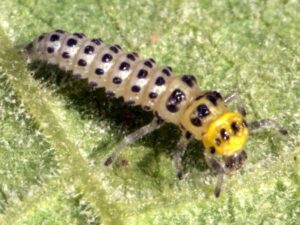 |
 |
Crickets, etc (Orthoptera)
|
Mole cricket (family Gryllotalpidae)
The mole cricket (family gryllotalpidae) is, as the name suggests, a type of cricket. The left hand photo was taken in our garden, whilst the right hand one is from the Internet.
Mole crickets are quite big (3-5cm) and a bunch of them had clearly been living underground in our veggie patch. Apparently they live in underground tunnels during the day and come to the surface at night to seek food.
Although the females have wings, as do some of the males, they apparently hardly ever use them (i.e. only to seek mates).
Unusually, the females make sounds as well as the males.
|
 |
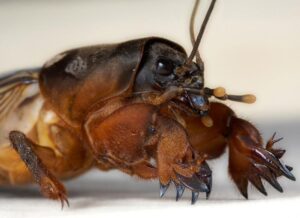 |
Dragonflies and damselflies (Odonata)
|
Australian emperor dragonfly
(Anax papuensis) and others
Dragonflies and damselflies change from aquatic juveniles to flying adults. But, unlike butterflies and beetles, this metamorphosis does not involve pupation. Rather, the aquatic juvenile simply crawls out of the water onto a leaf, splits its skin and the adult emerges, wings and all. The adult then flies off, leaving behind the cast-off exoskeleton.
The two photos are of exoskeletons left behind as the adult emerges. The left hand photo is of australian emperor dragonfly (Anax papuensis) and the right hand one is of an unknown damselfly.
|
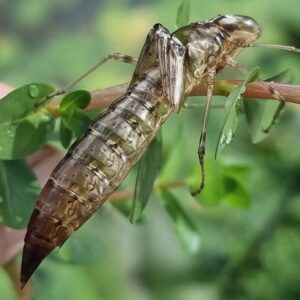 |
 |
Spiders (Araneae)
|
St. Andrew’s cross spider (Argiope keyserlingi)
The two photos are both of female St. Andrew’s cross spiders (Argiope keyserlingi in the family Araneidae), with the one on the left being the top side and the one on the right being from underneath. Whilst the females are ‘standard spider size’, the males of the species are apparently miniscule.
St. Andrew’s cross spiders are so called due to the construction of the silk bands forming the arms of an X-shaped cross in the centre of their web, supposedly similar to the one upon which St. Andrew is traditionally said to have been crucified. The purpose of this cross is not well understood. The spiders usually align 2 legs along each arm of the cross.
|
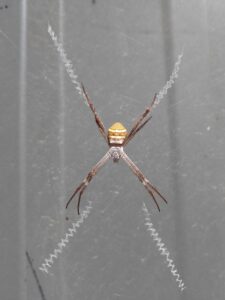 |
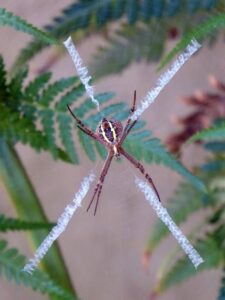 |
True bugs (Hemiptera)
|
Eucalyptus tip-wilter (Amorbus alternatus)
The eucalyptus tip-wilter has tube mouth parts that it uses to suck the sap out of eucalyptus leaves. So, a very apt common name!
The left hand photo is of a juvenile/nymph, whilst the right hand one is of an adult. As you can see, the colouration is very different between the two, such that the uninformed would presumably think that they are different species.
Both adult and nymph can apparently emit a foul odour if disturbed to deter potential predators.
|
 |
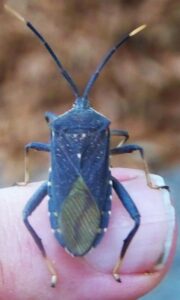 |
















